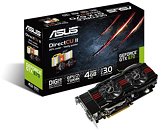Thursday, October 4th 2012

ASUS Announces 4 GB GeForce GTX 670 DirectCU II
ASUS announced the GTX670-DC2-4GD5, a new GeForce GTX 670 graphics card based on the DirectCU II 2-slot design. The card is armed with 4 GB of GDDR5 memory, across a 256-bit wide memory interface, clocked at 6.00 GHz (192 GB/s). The card implements a custom-design PCB, with 6+2 phase Digi+ VRM that uses SuperAlloy chokes (which don't whine on load). The Digi+ VRM controller provides a certain degree of software voltage control using the GPU Tweak tool. The GPU is clocked at 915 MHz, with 980 MHz GPU Boost frequency. The card draws power from two 6-pin PCIe power connectors. Display outputs include two DVI, and one each of HDMI and DisplayPort. The new 4 GB GeForce GTX 670 DirectCU II from ASUS is expected to be priced around US $450.

19 Comments on ASUS Announces 4 GB GeForce GTX 670 DirectCU II
cmiiw
EDIT: If it's solely about GTX 670's then you can substitute Galaxy's GC(the same card as the KFA2 afaiw).
I'd also assume that at the high end of the market, that vendors realise that a 4GB GTX 670 impinges on GTX 680 territory price wise. Most vendors probably also realise that potential buyers would note that 4GB is a niche product. I doubt there would be a high percentage of buyers that would opt for a 4GB 670 over a 2GB 680, especially with vendor OC'ed/cooled of the latter being in the same price range.
right now we can only wish for a game that takes that kinda vram capabilities
1, 2, 4, 8, 16, 32, 64, 128, 256, 512, 1024, 2048, 4096, 8192, 16384, 32768, 65536, 131072, 262144, 524288, 1048576, 2097152, 4194304, 8388608, 16777216, 33554432, 67108864, 134217728, 268435456, 536870912, 1073741824, 2147483648, 4294967296, 8589934592, 17179869184, 34359738368, 68719476736, 137438953472, 274877906944, 549755813888, 1099511627776, 2199023255552, 4398046511104, 8796093022208, 17592186044416, 35184372088832, 70368744177664, 140737488355328, 281474976710656, 562949953421312, 1125899906842624, 2251799813685248, 4503599627370496, 9007199254740992, 18014398509481984, 36028797018963968, 72057594037927936, 144115188075855872, 288230376151711744, 576460752303423488, 1152921504606846976, 2305843009213693952, 4611686018427387904, 9223372036854775808, 18446744073709551616, 36893488147419103232, 73786976294838206464, 147573952589676412928, 295147905179352825856, 590295810358705651712, 1180591620717411303424, 2361183241434822606848, 4722366482869645213696, 9444732965739290427392, 18889465931478580854784, 37778931862957161709568, 75557863725914323419136, 151115727451828646838272, 302231454903657293676544, 604462909807314587353088, 1208925819614629174706176, 2417851639229258349412352, 4835703278458516698824704, 9671406556917033397649408
So;
8 x 2Gbit IC's = 16Gbit (2 GB), and 8 x 32-bit I/O (each I/O circuit being 2 x16-bit data input/output)= 256-bit memory bus ( which run as four 64-bit memory controllers - one per Kepler GPC)
The simplest method of increasing memory capacity is to add memory IC's to the reverse side of the PCB mirroring the placement that already exists (i.e. the IC's sit above/below eachother with the PCB sandwiched between) and to run the memory I/O in what is called "clamshell mode", where each original combined 32-bit data input/output per memory IC is split into two 16-bit, with each of these 16-bit data I/O servicing the IC's.
So;
16 x 2Gbit IC's (4GB), and 16 x 16-bit data I/O = 256-bit memory bus
2GB - 4GB = 256 bit bus
Theres math involved. You cant just throw 3GB on a 256 bit bus, does not fit right.
And like that giant wall of numbers. Has to do with binary numbering.
decimal/ Base10 to binary/Base2 configuration
128 64 32 16 8 4 2 1 is the decimal set
1 0 0 0 0 0 0 0 is binary
so the decimal number of 128
is represented in binary as
100000000
ok lets take
128 64 16 8 4 2 1
0 0 0 1 1 1 1
pardon= 0001111
convert the 1s into a decimal number
I learned this in electronic Principles while in the Air Force, Mainly used it for Hexadecimal conversions too haha :toast:
0001111
take that binary number and convert it into a decimal number
take that binary number and convert it into a hexadecimal character or number
9671406556917033397649408 this decimal number
is i mean alot of 1s and zeros lmao
Also, while 4GB fits better with a 256-bit bus, it is possible to do 3GB. The memory controllers on these cards are actually broken into 32-bit controllers. With a 2GB card, each 32-bit controller has 1 2Gbit memory chip. However, if you wanted 3GB, you could put 2 2GBit memory chips on 4 of the 8 memory controllers. This is how they do the GTX660 with 2GB on a 192-bit bus. I don't believe 3GB is an approved configuration though.